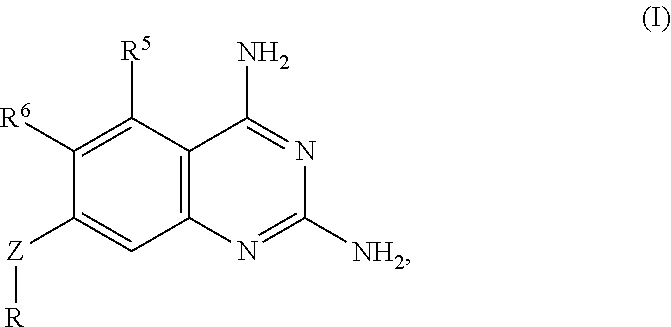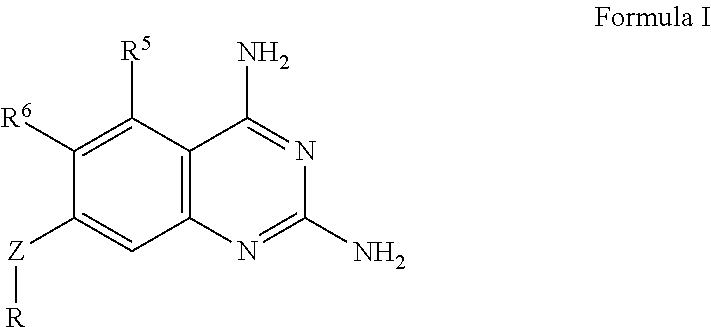Dihydrofolate reductase inhibitors
a reductase inhibitor and dihydrofolate technology, applied in the direction of antibacterial agents, drug compositions, antiparasitic agents, etc., can solve the problems of inability to activate the transport system of non-mammalian cells, limited utility of methotrexate, and continual medical problems of bacteria, etc., to inhibit the activity of dhfr
- Summary
- Abstract
- Description
- Claims
- Application Information
AI Technical Summary
Benefits of technology
Problems solved by technology
Method used
Image
Examples
example 1
Preparation of 3′-(cyanomethyl)-5-fluoro-2-methylbiphenyl-4-carbonitrile (3)
[0050]Tetrakis(triphenylphosphine)palladium (10 mg, 0.1 mmol) was added into the solution of 4-bromo-2-fluoro-5-methylbenzonitrile (110 mg, 0.5 mmol), K2CO3 70% aqueous solution (1 mL) and 3-(cyanomethyl)phenylboronic acid (96 mg, 0.6 mmol) in 10 ml N,N-dimethyl formamide, the solution was heated at 150° C. under microwave condition for 20 minutes, and the reaction mixture was partitioned with 20 mL water and 50 mL ethyl acetate, the aqueous layer was extracted with ethyl acetate (100 mL×2), and the combined organic layer was washed by saturated solution of sodium bicarbonate, sodium chloride, and dried by sodium sulfate, and concentrated by give quantitative products 3′-(cyanomethyl)-5-fluoro-2-methylbiphenyl-4-carbonitrile 3 (114 mg, 88% yield, confirmed by LCMS: 251.10) without purification for next steps.
example 2
Preparation of 2-(3-(2,4-diamino-6-methylquinazolin-7-yl)phenyl)-aceto-nitrile (4)
[0051]To the above solution of 3′-(cyanomethyl)-5-fluoro-2-methylbiphenyl-4-carbonitrile 3 was added guanidine carbonate (180 mg, 0.5 mmol) and N,N-dimethyl formamide (5 mL). The reaction was heated at 150° C. under microwave condition for 20 minutes. The mixture was purified by high performance liquid chromatography to yield compound 4 as white solid trifluoroacetic acid salt (89 mg, Yield: 68%, confirmed by LCMS: 290.15 and HPLC).
[0052]
Example (3)
Preparation of 4-(5,6-dimethyl-1H-benzo[d]imidazol-2-yl)-2-fluorobenzo-nitrile (3)
[0053]To a solution of 2-fluoro-4-formylbenzonitrile 1 (100 mg, 0.7 mmol) and 4,5-dimethyl benzene-1,2-diamine 2 (109 mg, 0.8 mmol) in ethanol (10 ml) was added a catalytic amount of p-toluenesulfonic acid (0.5 mg, 0.5 mmol). The mixture was stirred reflux for 2 hours and concentrated by rotor evaporation. The crude material was purified through column chromatography with 40% e...
example
(4)
Preparation of 2-fluoro-4-(1-(2-methoxyethyl)-5,6-dimethyl-1H-benzo[d]imidazol-2-yl)benzonitrile (4)
[0054]4-(5,6-dimethyl-1H-benzo[d]imidazol-2-yl)-2-fluorobenzonitrile 3 (110 mg, 0.4 mmol) was combined with 1-bromo-2-methoxyethane (76 mg, 0.55 mmol), NaH (13 mg, 0.55 mmol), and N,N-dimethyl formamide (5 ml). The reaction was heated at 100° C. for 1.5 hours. The product solution (confirmed by LCMS: 324.22) was carried on to the next step without purification.
PUM
| Property | Measurement | Unit |
|---|---|---|
| pharmaceutical composition | aaaaa | aaaaa |
| resistance | aaaaa | aaaaa |
| cancer cell resistance | aaaaa | aaaaa |
Abstract
Description
Claims
Application Information
 Login to View More
Login to View More - R&D
- Intellectual Property
- Life Sciences
- Materials
- Tech Scout
- Unparalleled Data Quality
- Higher Quality Content
- 60% Fewer Hallucinations
Browse by: Latest US Patents, China's latest patents, Technical Efficacy Thesaurus, Application Domain, Technology Topic, Popular Technical Reports.
© 2025 PatSnap. All rights reserved.Legal|Privacy policy|Modern Slavery Act Transparency Statement|Sitemap|About US| Contact US: help@patsnap.com



